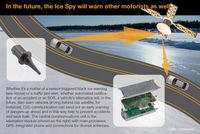The Ice Spy Provides Drivers Following Behind With Important Data
|
|
HANOVER, Germany – February 12, 2009: In the cold months of the year, black ice surprises motorists time and again. This is clearly reflected in the accident statistics. According to the Federal Office of Statistics, black ice and snow or ice were at the root of 5,230 accidents involving personal injury in 2007. To prevent drivers from being caught unawares by the danger, the international automotive supplier Continental is working on bringing an intelligent early-warning system to production readiness. The system will warn drivers following behind a vehicle so equipped of icy road conditions up ahead.
Mini-sensors – hardly any larger than a matchstick – measure the temperature and transmit this data to the board computer, which alerts the driver. Even more is planned for the future, though. Then the vehicles following behind will also be advised of the danger of black ice. The vehicle telematics itself becomes a sensor and informs drivers following behind. This warning of black ice or of any other change in road friction is just one aspect of car-to-car communication. Whether it’s a matter of accident or traffic jam alerts, tracking or SOS calls, tomorrow’s cars look more or less around the corner and very far ahead.
As Dr. Peter M. Kroll, of the University of Karlsruhe, notes: “Nowadays driver assist systems make a major contribution to reducing the number of traffic fatalities. Black ice detection is already possible today. It works by analyzing variables relating to driving dynamics at a vehicle’s momentary location. But the road conditions up ahead are, of course, of much greater interest. In the future, car-to-car (C2C) systems will provide valuable service in enabling vehicles to communicate with other vehicles and with the traffic infrastructure. It will make it possible for a vehicle detecting black ice to inform the vehicle behind it of this danger.”
The sensitive temperature sensor consists, among other things, of a head with sintered ceramics – a technology also used for china tableware or for isolators. A temperature change alters the electrical resistance of the material mix. This new value is then instantaneously transmitted to the board computer, which is networked to other vehicle systems, such as, for example, the electronic stability control (ESC) system.
By means of this and many other developments, Continental supports the European Road Safety Charter, whose goal is one of drastically reducing the number of traffic fatalities by 2010.



